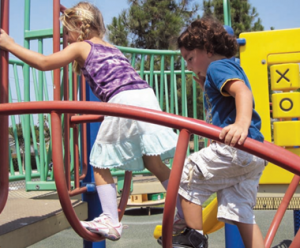11.1: Physical Development Introduction
Young children learn best by doing. Active physical play supports preschool children’s brain development and is a primary means for them to explore and discover their world. Physical activities enhance all aspects of development, including cognitive, emotional, social, as well as physical.
- Cognitive growth occurs when children problem-solve how to negotiate an obstacle course or how to build a fort.
- Emotional development is supported when children’s confidence and willingness to try new activities increase.
- Social development is supported through interaction with other children and the development of friendships through active play.
- Being active also has clear benefits for children’s health and fitness.

The preschool years are a prime time for children’s physical development. Preschool programs have a key role in maximizing children’s developmental potential during this important time by providing well-designed, regular, and frequent opportunities for physical play. Although many of the young children’s physical activities are exploratory and self-directed, children greatly benefit from adult encouragement and guidance when learning new physical skills. Teachers tap into children’s intrinsic motivation for movement by designing meaningful, culturally appropriate, and accessible play activities in which all children feel challenged yet successful.
Teachers play an important role in the area of physical development. Children benefit immensely when teachers engage in physical activities alongside children and share in the fun of physical movement. Just as important, preschool programs collaborate with family and community members to promote children’s physical development. Caregiver support and participation foster children’s active lifestyle habits. Promoting active lifestyles during the preschool years will benefit children throughout their lives.[2]

Feedback/Errata